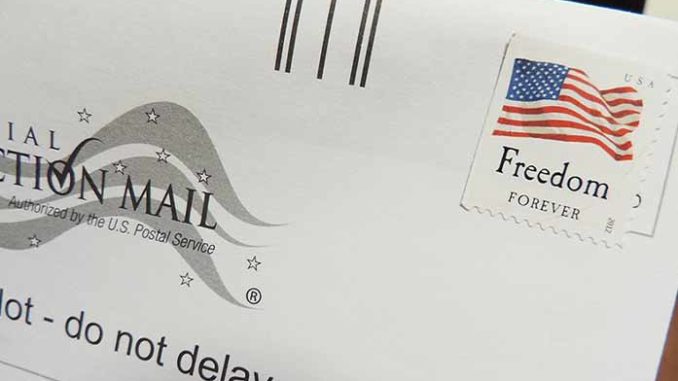
Ballots analyzed by the FBI for fingerprints. Envelopes of cash reportedly used to pay for ballots. Photo lineups used to identify suspects. A justice of the peace retaliated against.
Those are a few of the investigative details revealed in a series of reports written by Special Agent William Knuth of the Arizona Attorney General’s Office who was assigned to ferret out a ballot harvesting scheme in Yuma County.
Knuth made his first trip to Yuma County on Aug. 13, 2020, just nine days after Yuma County Sheriff Leon Wilmot was presented several videos secretly recorded outside two polling stations in the city of San Luis during the 2020 primary election.
Over the next few month, Knuth and Det. Sgt. Jason Hemstreet of the Yuma County Sheriff’s Office would interview more than a dozen people as they connected to dots which eventually resulted in two women -one a school board member and former San Luis mayor- pleading guilty to ballot abuse.
But the illegal election activities went far beyond the four ballots belonging to other people that the former mayor, Guillermo Fuentes, handed to Alma Yadira Juarez, who then turned the ballots in at the polling station. The women will be sentenced later this month, with Juarez guaranteed probation and Fuentes eligible for probation.
However, Knuth’s reports show the investigation into what local whistleblowers say was a long-running, well organized criminal conspiracy is far from over. One of those who spoke openly to investigators was Justice of the Peace Juan Guerrero.
“Guerrero spoke mainly of the long standing issues surrounding elections in San Luis,” Knuth wrote after his first trip to Yuma County. “Guerrero believes that this group, including Guillermina Fuentes, the suspect in this case, is exchanging money for the ballots of subjects within the community.”
During the interview, Guerrero also recounted how he previously had overwhelming support when he ran for justice of the peace. But just prior to the 2018 election, he approved a restraining order against an influential member of the group associated with Fuentes.
Afterward, Guerrero won the 2018 election by a very slim margin. “Guerrero attributes this to the group’s influence,” Knuth noted.
YCSO detectives also accompanied Knuth for an interview with a former employee of Fuentes’ company. The employee claimed she was given several envelopes of money while working for Fuentes in 2016 which she was instructed to give to people in exchange for ballots.
“Fuentes informed her who would come to pick up the envelopes, and at the time of pick up would either leave a ballot or provide a time when Fuentes could come pick up their ballot,” Knuth wrote of the interview. He added that the employee described the majority of the ballots as still being in the envelopes “as if they were just received in the mail” from the county recorder.
The employee estimated that an excess of fifty ballots were dropped off at Fuentes’ business leading up to the 2016 General Election.
As part of the 2020 ballot harvesting investigation, Yuma County detectives seized 38 suspicious ballot envelopes which had been placed in the drop box outside one of the two polling stations in San Luis. Hemstreet made sure staff members of the Yuma County Recorder’s Office “took care in handling the ballots and wore gloves,” according to a search warrant affidavit.
Photocopies were retained by the recorder’s office, while detectives took possession of the originals which were turned over to forensic technicians at the Yuma Police Department for a latent print examination. Fingerprints were also located on two ballots of interest.
The Arizona Department of Public Safety crime lab was also involved in the fingerprints examination. Eventually a number of fingerprint profiles taken from election workers and suspects, including Fuentes, was forwarded to the FBI in September 2020.
Knuth later noted that the two ballots examined as part of the investigation contained votes for only three candidates – the same three candidates being supported by Fuentes.
The investigators also interviewed several San Luis residents about contact they had with various people who offered to pick up ballots. During some of the interviews, a photo lineup was shown in an effort to identify various people involved in the effort to solicit the ballots.
During an initial interview, Fuentes denied filling out someone else’s ballot. But on Dec. 15, 2020, Knuth showed her a video clip in which Fuentes can be seen writing on something after taking a ballot out of the ballot envelope.
At that point, Fuentes provides conflicting statements as to whether she was filling out the other person’s ballot. She eventually admitted she may have “finished voting something” and “probably did finish filling” out a ballot someone else started.
The reports from the Attorney General’s Office also show Knuth interviewed Yuma County Recorder Robyn Stallworth Pouquette in February 2021.
“Robyn reported there have bene rumors over the years that a group of people sometimes led by Guillermina have collected signed ballots where voters were told the group would complete the ballots correctly,” Knuth noted after the interview. “Robyn stated this was common practice until the ballot harvesting law went into effect. Robyn stated this group now waits at the polling place for people to bring them the ballot.”
Knuth also noted Pouquette discussed a previous voter fraud complaint she had filed. She also mentioned that the FBI had conducted investigations in the past.
However, the Knuth reports released last week do not get into detail as to what, if anything, was learned from the FBI about those prior investigations. Many other pages of Knuth’s reports have not been released yet due to the ongoing active investigation into others who were involved in the ballot harvesting scheme.
LEARN MORE ABOUT FUENTES HERE

